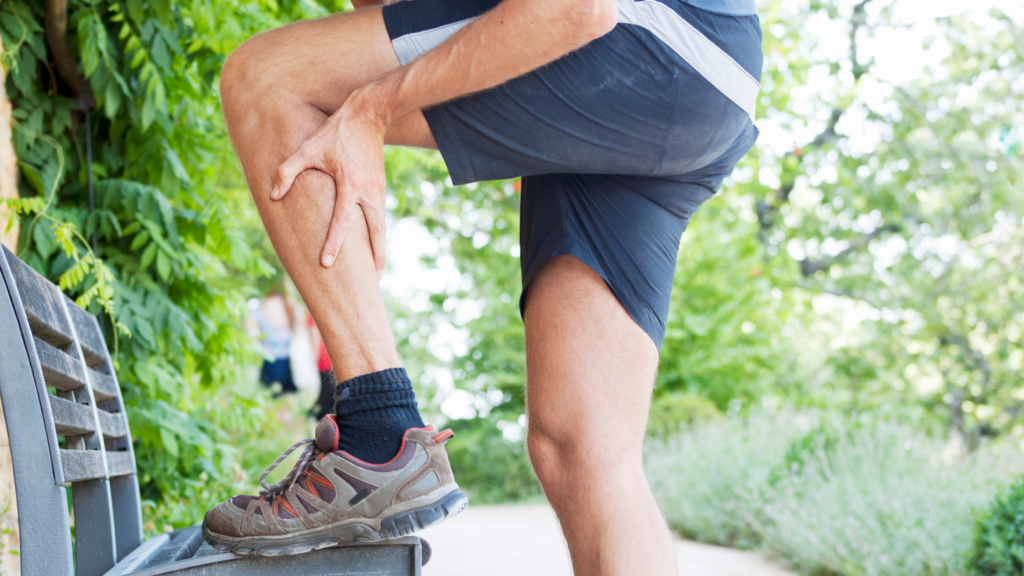A calf strain affects the muscles at the back of the lower leg, and
tends to come about due to a sudden excessive force through the
muscle, or with repetitive overuse.

A calf strain is an injury to the muscles of the back of the leg. Most commonly, calf strains are minor tears of some muscle fibers, but the bulk of the muscle tissue remains intact. More severe strains can cause a complete tear of the muscle and loss of function.
The calf is a group of muscles that allow you to point your foot and your toes downwards, generating the propulsive forces that help you to walk, run and jump.
WHO GETS CALF STRAIN
Anyone can get a pulled calf muscle. But these strains are more common in athletes who perform lots of stop-and-go movements with quick bursts of speed. Sprinters, football players, soccer players, and tennis players are prone to pulled calf muscles. Sometimes the injury is called “tennis leg.”
Other risk factors for pulled calf muscles include:
Age: People over 40 may be more likely to get strains during physical activity.
Sex: Some studies suggest that men are more likely to get calf muscle injuries.
Lack of conditioning: It’s important to warm up and stretch before physical activity and condition your muscles before the start of a sports season.
Muscle quality: People with tight or short calf muscles have a higher risk of calf strains.
The severity of your injury will dictate how long it will take you to recover. This can range from 1 week to 6 weeks or more, depending on how strict you are with your post-injury care routine. With the correct management, your injury should settle back to normal. Always consult a highly recommended physio for proper assessment.
DIAGNOSIS
Typically, individuals who sustain a calf strain notice a sudden, sharp pain in the back of the leg. The most common muscle injured when a calf strain occurs is the medial gastrocnemius. This muscle is on the inner side of the back of the leg.
The injury usually occurs just above the midpoint of the leg (between the knee and ankle). This area of the calf becomes tender and swollen when a muscle strain occurs.
An acute calf strain can be quite painful, depending on the severity of the injury. Calf strains are usually graded as follows:1
Calf strains are usually graded as follows:1
Grade I calf strain: Mild discomfort, often minimal disability. Usually minimal or no limits to activity.
Grade II calf strain: Moderate discomfort with walking, and limited ability to perform activities, such as running and jumping; may have swelling and bruising associated.
Grade III calf strain: Severe injury that can cause the inability to walk. Often patients complain of muscle spasm, swelling, and significant bruising.
If you have symptoms of a severe calf strain, you should be evaluated for proper treatment. Some signs of a severe calf strain include:
Difficulty walking
Pain while sitting or at rest
Pain at night
TREATMENT PLAN
You should rest until you are pain-free to allow the injured muscle to heal. Resting inadequately may prolong your recovery.
PHYSIOTHERAPY. You should work with highly-recommended physiotherapist to determine the treatment appropriate for your condition. Certain modalities, such as acupuncture and therapeutic massage, may be helpful in addition to exercise-based therapy.
ICING THE INJURY. Ice can be an excellent additional aid in settling any bruising and/or swelling. Be sure to wrap your ice in a damp cloth and monitor your skin to avoid ice burns.
HEAT APPLICATIONS. Before activities, gentle heating can help loosen the muscle. Apply a heat pack to the calf prior to stretching or exercising. As a general rule of thumb, remember to heat the area before and ice after.
CALF MUSCLE STRETCHING. Gentle stretching is helpful, but it should not be painful. Stretching excessively can be harmful and slow the healing process. There are some simple calf stretches that can help you along with your rehab.
Help your body to recover by elevating your leg for short periods in the early phase. This will help any swelling and bruising to disperse..
After the initial injury it may be wise to reduce the amount of walking you do, and any other activities that use these muscles such as running and jumping. Go for non-weight bearing activities instead to keep you fit and active, such as cycling and swimming.
To help with the recovery and the uncomfortable symptoms you are experiencing, it may be advised to perform small circles and ankle pumps now and then to avoid stiffness. This will also help your body to keep the blood pumping around your tissues.
You may be assessed to try and establish why the injury occurred in the first place. Perhaps you are weak elsewhere and so overuse your calf muscles as a consequence, or perhaps you need better structure to your activity regime. You will likely be given some exercises to help you to recover fully from your injury.
These may include stretches to address any tight areas in your leg, and strength exercises to get you back up to your usual level of fitness. Whatever the reason for your injury, be sure not to rush your rehab. With patience and the correct guidance, you’ll be back to doing what you love most.
PREVENTION
How can I prevent a pulled calf muscle? You can reduce your risk of a pulled calf muscle by:
Keeping your calf muscles strong and conditioned.
Stretching routinely.
Not pushing through pain.
Resting and recovering between workouts.
Using proper technique when playing sports.
Warming up and stretching your calf muscles before physical activity.
Wearing supportive footwear that fits properly.


